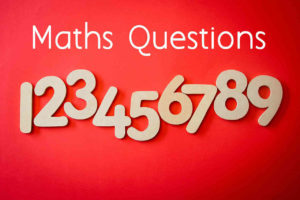Math Quiz Questions Answers – General Mathematics Quizzes

Online Math Quiz Questions and Answers part 1 ( Mathematics Quizzes 1-25)
1) Who wrote the first textbook in Differential calculus?
Answer: Guillaume de l’Hôpital.
2) Some staircases are in the form of a:
Answer: Spiral.
3) Who is the author of “The Fractal Geometry of Nature”, an important contribution to understanding form and complexity in the physical universe?
Answer: Benoit Mandelbrot.
4) When did Al-Khwarizmi write the popular book which introduced Indian numbers and zero to the Arab world?
Answer: A.D. 820.
5) Who wrote the classic “The Paradoxes of the Infinite”?
Answer: Bernard Bolzano.
6) Our measurement of time is based on:
Answer: Sexagesimal number system.
7) Who wrote “Liber Abaci” which introduced the Indian number system and zero to Europe?
Answer: Fibonacci.
8) When were Indian mathematicians leaders in the world of mathematics?
Answer: 6″‘ to 10th century.
9) Which mathematician wrote “Discourse on Method” in bed when he was hardly 16 years old and had studied mathematics for a few months only?
Answer: René Descartes.
10) The thread of a bolt is in the form of a:
Answer: Circular helix.
11) Who wrote the classic “On Growth and Form” a mathematical treatment of natural history?
Answer: D’Arcy Wentworth Thompson.
12) When did the first printed book on mathematics appear?
Answer: 1478.
13) Who wrote the popular ‘One, Two, Three Infinity’, a book on numbers and their relationship with the cosmos?
Answer: George Gamow.
14) What is the number which may vary from time to time, does not leave one till one has finished studies?
Answer: Roll number.
15) Who is the author of “Mathematical Ideas, Their Nature and Use”?
Answer: Jagjit Singh.
16) When was the problem of “Seven Bridges of Konigsberg” posed?
Answer: 1736.
17) Who wrote the mathematical masterpiece “Gödel, Escher, Bach: an Eternal Golden Braid”?
Answer: Douglas Hofstadter.
18) Which household gadget occasionally operates on a special sequence of number?
Answer: Lock (It is called a ‘combination lock’).
19) Who discovered the oldest document on Mathematics?
Answer: Alexander Henry Rhind.
20) When was the “Four color conjecture” every map on a flat surface or a sphere can be cultured without using more than four different colors – proved?
Answer: 1976.
21) This mathematician’s original work on geometry was ignored in his lifetime and was recognized as a masterpiece two centuries later when a handmade copy of his printed work was accidentally discovered among his pupil’s papers. Who was he?
Answer: Girard Desargues.
22) Every day one follows the numbers of this table. What is it?
Answer: Calendar.
23) Who wrote the witty and amusing book “A Budget of Paradoxes”?
Answer: Augustus De Morgan.
24) When this book was published, a timorous editor added a note claiming that the author had forwarded the revolutionary theory mentioned in it as a mathematical convenience and not as reality. Which is that book?
Answer: De Revolutionibus Orbium Coelestium.
25) Who is the author of the classic ‘Men of Mathematics”?
Answer: Eric Temple Bell.
General Math Quiz Questions and Answers part 2 ( Mathematics Quizzes 26-50)
26) Sugar is occasionally served in the form of a:
Answer: Cube.
27) When this book was published, a timorous editor added a note claiming that the author had forwarded the revolutionary theory mentioned in it as a mathematical convenience and not as reality. Which is that book?
Answer: De revolutionibus orbium coelestium.
28) Which book became popular as “The Red Monster” among not only mathematicians but also physicists, engineers, statisticians, etc. as a handy reference?
Answer: The Handbook of Mathematical Functions.
29) Which book became popular as “The Red Monster” among not only mathematicians but also physicists, engineers, statisticians etc, as a handy reference?
Answer: The Handbook of Mathematical Functions.
30) What is the Christmas Star known as?
Answer: Dodecagon.
31) Who wrote the classic “On computable numbers, with an application to the Entscheidungsproblem” that dealt with logic in calculations?
Answer: Alan Turing.
32) “Epicycles” were employed to explain the orbits of planets and the sun around the earth in the theory of the universe forwarded by:
Answer: Claudius Ptolemy.
33) “Researches into the Mathematical Principles of the Theory of wealth” is the first systematic treatise on the application of mathematics to economics. Who wrote it?
Answer: Antoine Augustin Cournot.
34) One’s score in an I.Q test is known as ones:
Answer: Intelligence quotient.
35) Who wrote the classic entertainer “Mathematical Recreations and Essays”?
Answer: W. W. Rouse Ball.
36) “Researches into the Mathematical Principles of the Theory of wealth” is the first systematic treatise on the application of mathematics to economics. Who wrote it?
Answer: Augustin Cournot.
37) Who wrote the first systematic text on trigonometry?
Answer: Johannes Peter Müller.
38) When we have to go by bus, we remember this number:
Answer: Transport number.
39)Who wrote the classic “Logic Machines and Diagrams”?
Answer: Martina Gardner.
40) Who wrote the classic entertainer “Mathematical Recreations and Essays”?
Answer: W. Rouse Ball.
41) Who is the author of “Mathematics for the Million”, a lucidly written book giving the origins and fundamentals of mathematics?
Answer: Lancelot Hogben.
42) What is brick called in geometrical terms?
Answer: Cuboid.
43) Who wrote the classic “Proofs and Refutations” in which he argued that mathematics is not infallible and is subject to correction and criticism?
Answer: Imre Lakatos.
44) Who wrote the first systematic text on trigonometry?
Answer: Johannes Muller.
45) Who wrote the quaint book “Sand Reckoner” in which the universe was considered to be made up of sand grains and their count was made?
Answer: Archimedes.
46) When numbers are assigned to a person on the basis of his performance in studies, they become:
Answer: Marks.
47) Who wrote, “The Analyst” which attacked the then newly conceived calculas invented by Isaac Newton?
Answer: George Berkeley.
48) Who wrote the classic “Logic Machines and Diagrams”?
Answer: Martina Gardner.
49) This book was used as a school textbook in Persia for hundreds of years. Which is that book?
Answer: The Algebra of Omar Khayyam.
50) This measuring device is often misused. What is it?
Answer: Foot-rule (It is often employed to beat students).
Basic Math Quiz Questions Answers part 3 ( Mathematics Quizzes 51-75)
51) Which journal gives an up-to-date information on the current world literature in mathematics especially for researchers?
Answer: Mathematical Reviews.
52) Who is the author of “Mathematics for the Million”, a lucidly written book giving the origins and fundamentals of mathematics?
Answer: Lancelot Hogben.
53) ‘Lady Luck’ is the title of a popular science book on:
Answer: The theory of probability.
54) A pencil is often in the form of a:
Answer: Cylinder (Pencils are also in the form of hexagonal and triangular prisms).
55) The oldest journal devoted chiefly to advanced mathematics is:
Answer: Journal de l’École polytechnique.
56) Who wrote the classic “Proofs and Refutations” in which he argued that mathematics is not infallible and is subject to correction and criticism?
Answer: Imre Lakatos.
57) Which is the most unreadable mathematical classic?
Answer: Principia Mathematica.
58) When we enter a foreign country, this number is essential:
Answer: Passport number.
59) The ratio of the width of a TV picture to the height is known as “aspect ratio”. What is it?
Answer: 4:3.
60) Who wrote the quaint book “Sand Reckoner” in which the universe was considered to be made up of sand grains and their count was made?
Answer: Archimedes.
61) A body leaps up or is thrown up. Thereafter it falls back to the earth. Its flight traces a:
Answer: Parabola.
62) The earth is in the shape of:
Answer: An oblate spheroid.
63) What is the structure of a DNA molecule?
Answer: Double helix.
64) Who wrote, “The Analyst” which attacked the then newly conceived calculus invented by Isaac Newton?
Answer: George Berkeley.
65) The shell of a snail has a shape resembling:
Answer: A logarithmic spiral.
66) What is the number attached to a book when it is kept in a library?
Answer: Accession number.
67) Eggs are often:
Answer: Oval-shaped.
68) This book was used as a school textbook in Persia for hundreds of years. Which is that book?
Answer: The Algebra of Omar Khayyam.
69) Zodiac signs are in all:
Answer: Twelve.
70) Quality control of products manufactured in an industry is conducted using:
Answer: Statistical techniques.
71) When a snake coils itself, it forms somewhat geometrical pattern. What is it?
Answer: The Spiral of Archimedes.
72) Which journal gives up-to-date information on the current world literature in mathematics especially for researchers?
Answer: Mathematical Review.
73) The arrangement of leaves on the stem of a rose follows the pattern of:
Answer: A helix.
74) Which ratio is most pleasing to the eye?
Answer: Golden ratio.
75) The population of rabbits follows:
Answer: Fibonacci sequence.
Top Math Quiz Questions with Answers part 4 ( Mathematics Quizzes 76-100)
76) ‘Lady Luck’ is the title of a popular science book on:
Answer: The theory of probability.
77) The horns of wild sheep are in the form of a:
Answer: Logarithmic spiral.
78) Egyptian pyramids are actually:
Answer: Square-based pyramids.
79) A tree, a snail, a volcano, the earth, a galaxy, – all are:
Answer: Turing machines.
80) The oldest journal devoted chiefly to advanced mathematics is:
Answer: Journal de l’Ecole polytechnique.
81) Who said, “The deep study of nature is the most fruitful source of mathematical discovery”?
Answer: Joseph Fourier.
82) The dish of a radio telescope is:
Answer: Concave in shape.
83) Honeybees communicate information through dances. What kind of figure do they make while dancing?
Answer: Eight.
84) Which is the most unreadable mathematical classic?
Answer: Principia Mathematica.
85) Which type of fish looks like a pentagram?
Answer: Starfish (Some species have however six arms. They look like a hexagram).
86) Which geometrical concept is employed to make maps of the world?
Answer: Mercator’s projection.
87) Climbing views grow naturally in the form of:
Answer: Helix.
88) Both Rene Descartes and Pierre de Fermat are considered to be the founding father of this subject. What is the subject?
Answer: Analytical Geometry.
89) Who said, “All the effects of nature are only mathematical consequences of a small number of immutable laws”?
Answer: Pierre-Simon Laplace.
90) The patterns of history are:
Answer: Cyclical.
91) Who mathematically predicted the presence of the planet Neptune?
Answer: John Couch Adams.
92) Who is the founding father of modern analysis?
Answer: Augustin Cauchy.
93) Which heavenly body appeared soon after it was discovered and then lost – at the precise position predicted by mathematical tools:
Answer: Ceres.
94) When a heavy, flexible cable or rope is suspended from two points, say two pylons, it forms:
Answer: Catenary curves.
95) Who gave the four key laws of electromagnetism in precise mathematical form?
Answer: James Clark Maxwell.
96) These two mathematicians founded the theory of probability. Who are they?
Answer: Pierre de Fermat and Blaise Pascal.
97) Which mathematical concept is used to stimulate the shapes, designs and patterns seen in nature?
Answer: Fractal.
98) Which subject is often employed in advertisements to boost up the sales of products?
Answer: Statistics.
99) Someone did a simple mathematical calculation and forwarded a revolutionary biological theory. What was that theory?
Answer: The theory of circulation of blood.
100) Who founded the Logistic School of Mathematics?
Answer: G.W. Leibniz.
Read more > Quiz Questions and Answers

